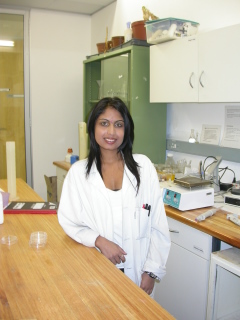
Contact
Room 05-006, Biological and Conservation
Science Building, Westville Campus
Tel: +27 31 2608657
Fax: +27 31 2601195
E-mail: 205503848@stu.ukzn.ac.za
Project:
Investigations on oxidative metabolism and the related use of antioxidants to promote shoot development by axes from recalcitrant seeds during procedures associated with cryopreservation.
Current Research
ROS mediated oxidative damage to shoot apical meristems of recalcitrant embryonic axes has been shown to occur after excision, chemical cryoprotection, flash-drying and/or cryogenic exposure, all neccessary steps for the cryopreservation procedure. These degradative oxidative processes which occur throughout cryopreservation, are one of the major problems precluding our success for production of vigorous plantlets after the cryo process. Therefore the current project broadly aims to investigate the underlying causes of failure of successful shoot production after cryopreservation, which is believed to be associated with uncontrolled ROS generation, and focuses on ways to ameliorate the consequences of unbalanced oxidative metabolism. To obtain success in counteracting oxidative injury, the work looks at both biomarkers of injury (various free radicals) and the response of endogenous antioxidative systems after exposure to stress. The first breakthrough in the study was recently reached when shoot production after excision was obtained using exogenic antioxidant treatment (dilute solution of DMSO) (Naidoo et. al, 2011) and now focuses on the use of cathodic water (a cathodic fraction of an electrolysed solution of calcium and magnesium chloride) as a alternate, non-toxic, free-radical scavenger.
Publications
NAIDOO, CASSANDRA, BENSON, E., BERJAK, P., GOVEIA, M. and PAMMENTER, N.W. (2011). Exploring the use of DMSO and ascorbic acid to promote shoot development by excised embryonic axes of recalcitrant seeds. CryoLetters 32, 166-174.